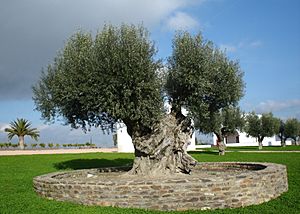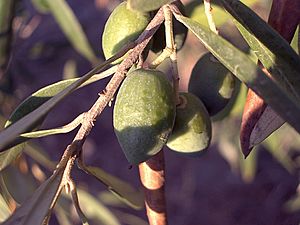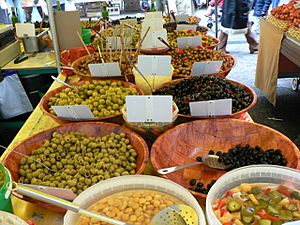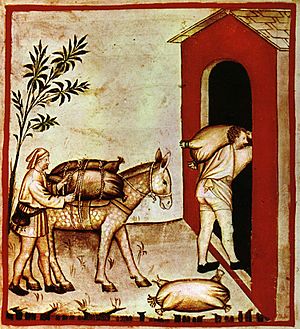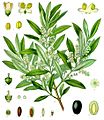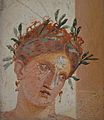Olive tree facts for kids
Quick facts for kids Olive |
|
|---|---|
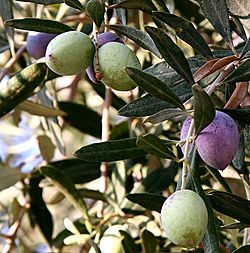 |
|
| Olea europaea, Dead Sea, Jordan | |
| Scientific classification | |
| Kingdom: | |
| Division: | |
| Class: | |
| Order: | |
| Family: | |
| Genus: |
Olea
|
| Species: |
O. europaea
|
| Binomial name | |
| Olea europaea |
|
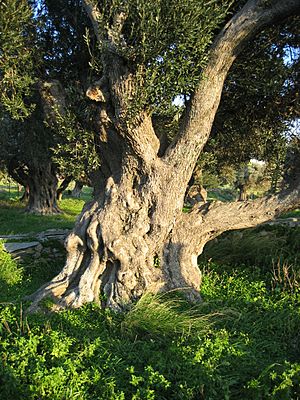
The olive tree is a small tree. Its scientific name is Olea europaea. A long time ago, it came from the coastal areas of the eastern Mediterranean, from Syria and the maritime (next to the sea) parts of Asia Minor and northern Iran at the south end of the Caspian Sea. It has been farmed for a very long time. The Ancient Greeks were farming it. They spread the trees to the western part of the Mediterranean.
Olive trees like soil with lots of chalk in it. They grow best on limestone slopes and crags in coastal climate.
Contents
Description of the tree
The Wild Olive is a small tree or shrub that grows up to 8–15 m tall with thorny branches. The leaves are opposite, 4–10 cm long and 1–3 cm wide. The leaves have a dark greyish-green color above and are pale with whitish scales below. The small white flowers, with calyx and corolla divided into four parts, two stamens and bifid stigma, are mostly on the last year's wood, in racemes coming up from the axils of the leaves. The fruit is a small drupe 1–2 cm long, thinner-fleshed and smaller in wild plants than in orchard cultivars.
Uses of olives
Today, olive trees are grown for the following reasons:
- The fruit of the tree is used:
- The wood of the tree is very hard. It is used to make furniture or articles of everyday use.
- The leaves of the tree have some medical uses. It is said that the leaves have a calming effect. They are good for people going to sleep. They are also good for the immune system and to bring down high levels of cholesterol. The oil is good for the cardiovascular system (the heart, and the arteries, etc.) and the circulation of fat in the body.
The numbers behind
In total, about 17.3 million tons of olives are produced every year. 60% of all olive trees are in the European Union. The top producers are:
Cultural significance
Very probably, the first olive trees were grown in Syria.
The branches in the flag of the United Nations are those of an olive tree.
In Christianity, the olive tree can be a sign of peace, because according to the Bible, a dove brought an olive branch to Noah to show that the flood was over.
The olive tree is the National tree of Palestine.
Images for kids
-
Roman fresco of a woman with red hair wearing a garland of olives, from Herculaneum, made sometime before the city's destruction in 79 AD by Mount Vesuvius (which also destroyed Pompeii).
-
Vat room used for curing at Graber Olive House
-
Andalucía, Spain
-
As an invasive weed, Adelaide Hills, South Australia
-
Cailletier cultivar, with a harvest net on the ground, Contes, France
-
Shōdo Island, Japan
-
Near Alexandroupolis, Greece
See also
 In Spanish: Olivo para niños
In Spanish: Olivo para niños


